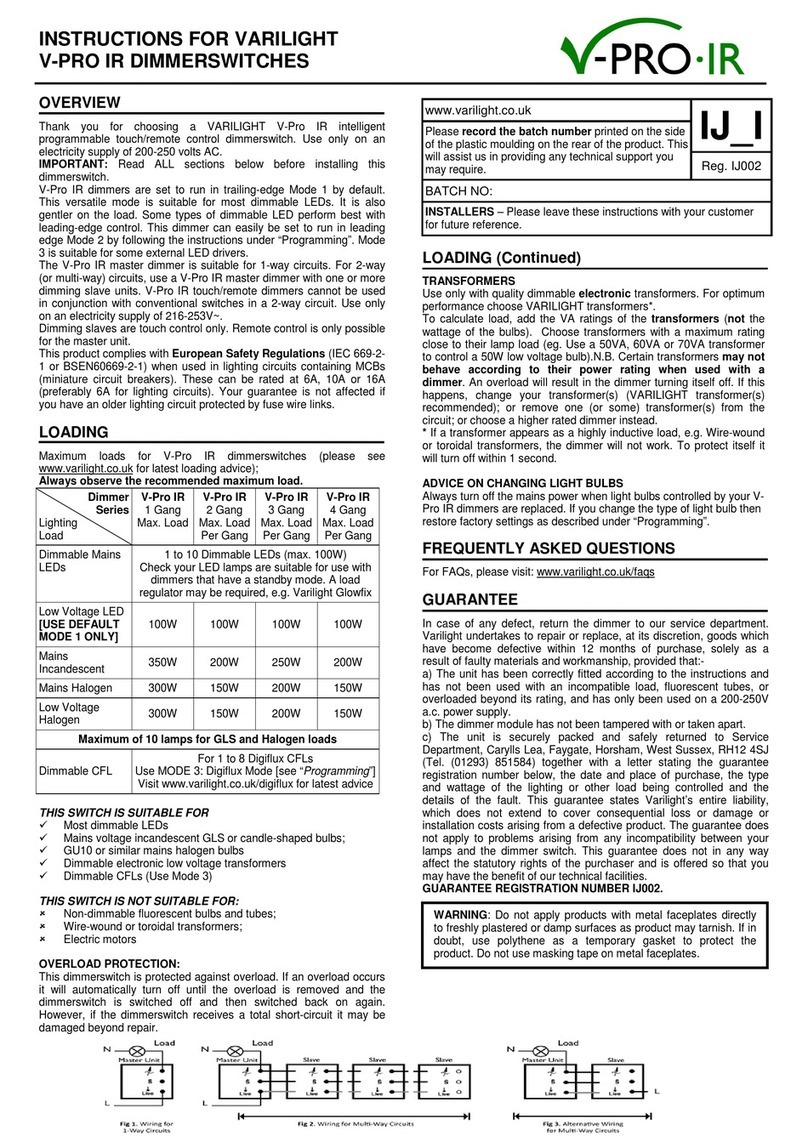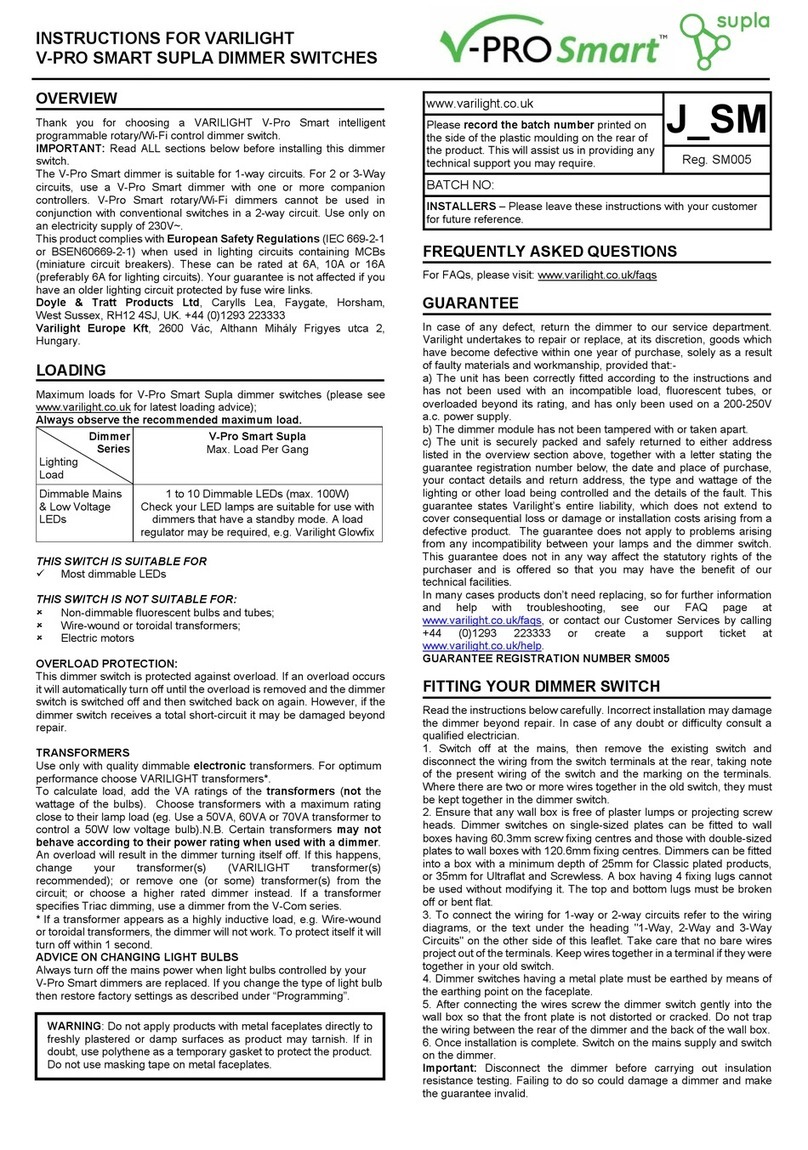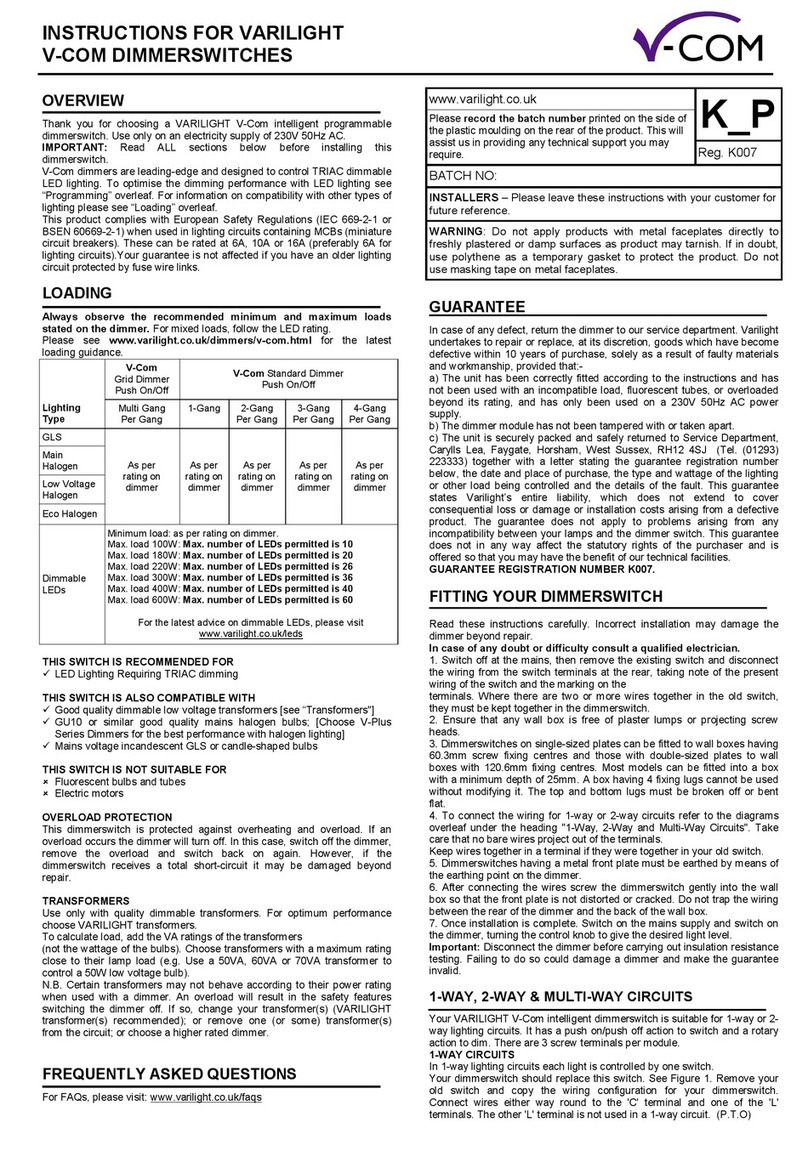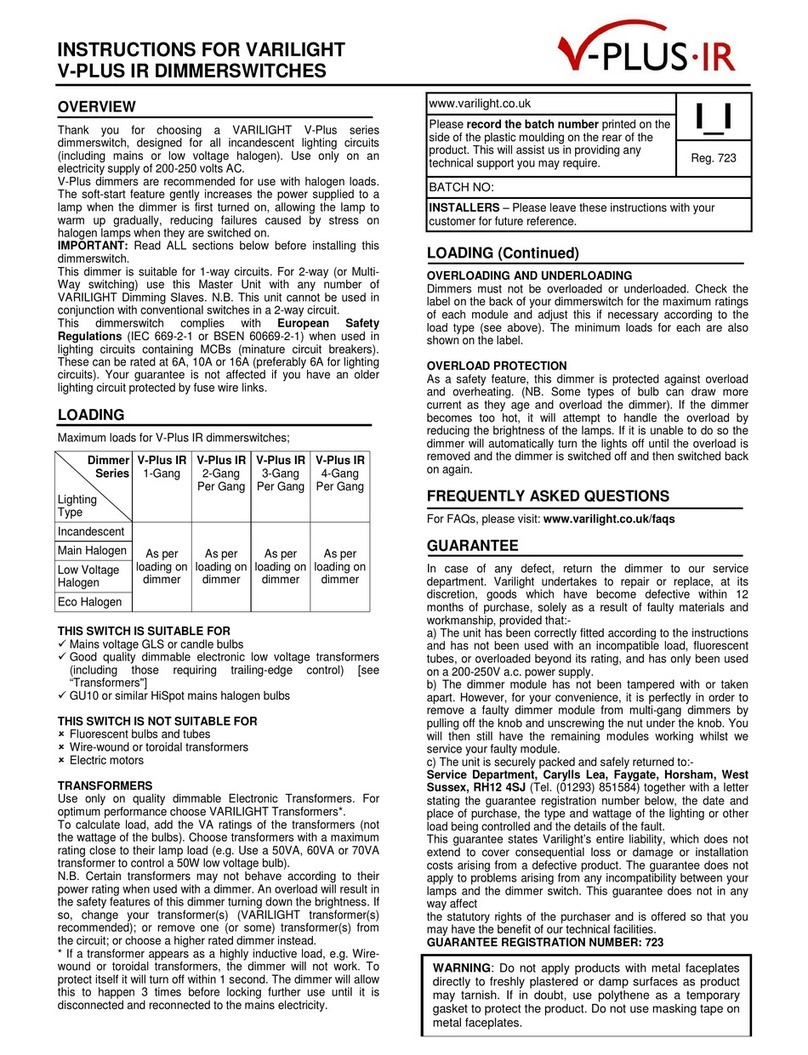
OPERATION OF THE SWITCH
To initialise the dimmer, press the circular button on the front of the plate once for 2 seconds. The dimmer will respond by making the light(s)
brighter. A single press will now turn the light(s) on or off. To dim the lights, keep contact with the sensor until the desired light level is reached.
While contact with the sensor is maintained, the brightness will cycle up and down. To change the direction of the dimming cycle release and
then press the button again. When the brightness reaches the level you require, remove contact with the button.
Dimmers are pre-programmed to respond to button 1 and button 8 on the VARILIGHT remote control handset (purchased separately). Alternatively,
dimmers can be re-programmed to respond to any other button (2 to 7) on the VARILIGHT remote control handset or a spare button on many other
remote control handsets. [* See box below: USING YOUR OWN REMOTE CONTROL HANDSET]. If there is a button that you do not currently use
then you may be able to use it to control the dimmer by following these steps carefully (do not omit step 3):-
1. To set the dimmer into learning mode tap the sensor 6 times,
roughly once per second (each tap causes the light(s) to turn on or
off). After 6 taps on the sensor the lights will step up and down and
go off.
2. Within 15 seconds and from a distance of less than 1 metre
(3 feet) away, pointing directly at the button on the dimmer,
press and hold down the chosen button on the handset,
releasing after holding it down for a least 2 seconds.
The light(s) will turn on and turn off.
3. To confirm your choice, press and hold down the same button again, releasing after holding the button down again for at least 2 seconds.
If the programming has been successful, the light(s) will turn on and turn off. The lights then step up and down once to confirm. Try
controlling the dimmer with the remote control. If it does not respond return to step 1 above and try again. If the problem persists, try a
different button, a different remote control unit or purchase the dedicated VARILIGHT controller.
4. You can now use this button on the remote control to operate the dimmer. As with the touch sensor, a single touch on the remote control
button will turn the light(s) on and off. Holding the button down will make the brightness cycle up and down. To change the direction of the
dimming cycle remove contact and then press the button again. Release contact from the button when the desired light level is reached.
The dimmer can still be operated using the touch sensor.
5. For 2- gang models, repeat steps 1 to 4 for each sensor, teaching each one a different button so you can control each one separately.
You can change your choice of control button by following steps 1 to 4 again at any time.
SCENE SETTING: Even if you program the dimmer to recognise another button, it will still respond to button 8 on the VARILIGHT handset.
Therefore you can control several dimmers at once using button 8 provided the dimmers are within range of the VARILIGHT handset. For
example you could set a different light level for each of the remote control dimmers in a room using their individually assigned buttons and then
turn them all on and off with a short touch of button 8.
* USING YOUR OWN REMOTE CONTROL HANDSET: If you have a spare button on an existing remote control handset then you may be able
to use it to control this dimmer. Not all handsets are compatible with VARILIGHT dimmers but many are. If you try and program the dimmer using
your own handset and find that it does not respond then you will need to buy a VARILIGHT handset instead. In some cases the dimmer may
appear to learn the signal from your own handset but then respond to other handsets as well. In this case please use the reset function to restore
factory settings and buy a VARILIGHT handset instead. For best results, always choose a VARILIGHT handset.
RESTORE FACTORY SETTINGS: Follow step 1 above. Press and hold the touch button on the dimmer for at least 4 seconds. The light will then
come on and fade to off to signal that the dimmer has been reset to its factory settings.
FREQUENTLY ASKED QUESTIONS
1. Is it normal for the dimmer to be warm to the touch even when the lights are off? A small current passes through the dimmer even when it is off to maintain its
memory. This can cause the dimmer to feel warm to the touch.
2. Should I be concerned if the dimmer is very warm during use? The dimmer will become warm during use. The more lights the dimmer is controlling, the hotter it will
become. On its maximum load the dimmer can become very warm. As long as you have not overloaded the dimmer, this is no cause for alarm. If the dimmer is overloaded
it will turn the lights down or off.
3. What happens if I have a power cut? If for any reason the power is lost to the dimmer, it will still remember the button you have programmed it to respond to.
4. Why won’t my dimmer respond to the remote control? Check batteries are not flat and are connected properly to the contacts in the casing. Make sure you point the
remote control in the direction of the switch and that there is nothing in the way to block the signal. Move closer to the switch. For best results use the VARILIGHT handset.
5. The touch button does not work properly. This can be caused by the live and load wires being in the wrong terminals (see wiring diagram overleaf) or by the earth
wire not being properly sleeved.
6. The lights seem to be less bright when on full brightness. If the lights are drawing too much current the dimmer will attempt to handle this overload by reducing the
brightness of the lamps. This can occur when certain types of bulb age.
7. The dimmer keeps turning itself off.
(a) The dimmer may be doing this because it is grossly overloaded. Use lower wattage bulbs or dimmable electronic transformers to reduce the load. Otherwise use the
dimmer elsewhere on a suitable load.
(b) The dimmer will also turn off if you are trying to control an unsuitable inductive load (such as a wire-wound or toroidal transformer). In this case change the load to a
dimmable electronic transformer. If the dimmer is still “blocked” disconnect from and then reconnect to the mains electricity supply.
8. The dimmer responds to other buttons on my remote control handset(s). Repeat the programming procedure above, paying particular attention to holding the
handset less than a metre (3 feet) from the front of the dimmer and pointing directly at the lens when you press your chosen button. Be sure to complete the programming
procedure by confirming your choice as described at stage 3 of the programming instructions. For best results use the VARILIGHT handset.
9. How many slaves can be used with a master unit in a multi-way circuit? Any number of slaves can be used as long as the total cable length from the master to the
last slave is less than 50m.
GUARANTEE
Important: In case of any defect return the dimmer to our service department. This guarantee is in addition to and not in derogation of the statutory
rights of the purchaser and is offered so that you may have the benefit of our technical facilities. Should any defect occur in this unit within 12 months
of its purchase we will replace or repair the defective unit free of charge provided that: the unit has been correctly fitted according to the instructions
and has not been used with fluorescent bulbs, energy saving bulbs, or overloaded beyond its rating, and has only been used on 200-250V A.C; the
dimmer has not been tampered with or taken apart; the unit is securely packed and safely returned to Service Department, Carylls Lea, Faygate,
Horsham, West Sussex, RH12 4SJ (Tel. (01293) 851584) together with a letter stating your name and address, the guarantee registration number
below, the date and place of purchase, the type and wattage of the lighting or other load being controlled and the details of the fault.
GUARANTEE REGISTRATION NUMBER 802.
























